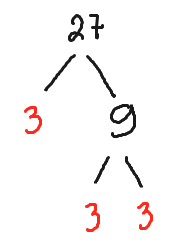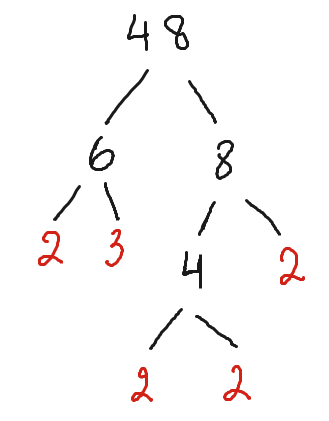Every number can be factored into prime factors. Prime factors are the factors that are prime numbers.
Prime numbers are the numbers that can only be divided by 1 and itself. For example, 3 is a prime number, because it can only be divided by 1 and itself. 6 on the other hand is not a prime number, because it can be divided by 1, by itself, by 2 and by 3.
Note: 1 is not considered a prime number because it can only be divided by 1 and nothing else. A prime number would have two different factors, 1 and another factor.
So following the example above, number 6 has two prime factors, 2 and 3. And it can be written as a product of the prime factors such as 6 = 2 x 3.
To help with factoring a number into prime factors, factor tree can be used. Factor tree is a tool to help break a number down to its prime factors. See pictures of the factor tree below for examples 2 and 3.
Example 2
Use factor tree to factor 27 to its prime factors and then write 27 as a product of prime factors.
27 is product of 3 and 9. The first factor, 3 is a prime factor, but 9 is not a prime factor, because it can be divided also by 3 besides 1 and itself.
Then we have to factor 9 into its prime factors, which are 3 and 3.
Now we can rewrite 27 as a product of its prime factors, 27 = 3 x 3 x 3.
Factor tree for 27

Example 3
Write 48 as a product of prime factors.
48 can be written as a product of 8 and 6.
48 = 6 x 8
But neither 6 or 8 are prime factors. Therefore we need to break down each one into its prime factors.
6 can be written as a product of 2 and 3.
6 = 2 x 3
Both 2 and 3 happen to be prime factors. So this is where we stop with 6.
Factor tree for 48

8 can be written as a product of 4 and 2.
8 = 4 x 2
2 happens to be a prime factor already, but not 4. So we continue breaking 4 down into its factors. 4 factors to 2 and 2.
4 = 2 x 2
Now 2 does happen to be a prime factor, therefore we are done with it.
So at end, when we combine all the prime factors for 6 and 8, we can rewrite 48 as
48 = 2 x 3 x 2 x 2 x 2
